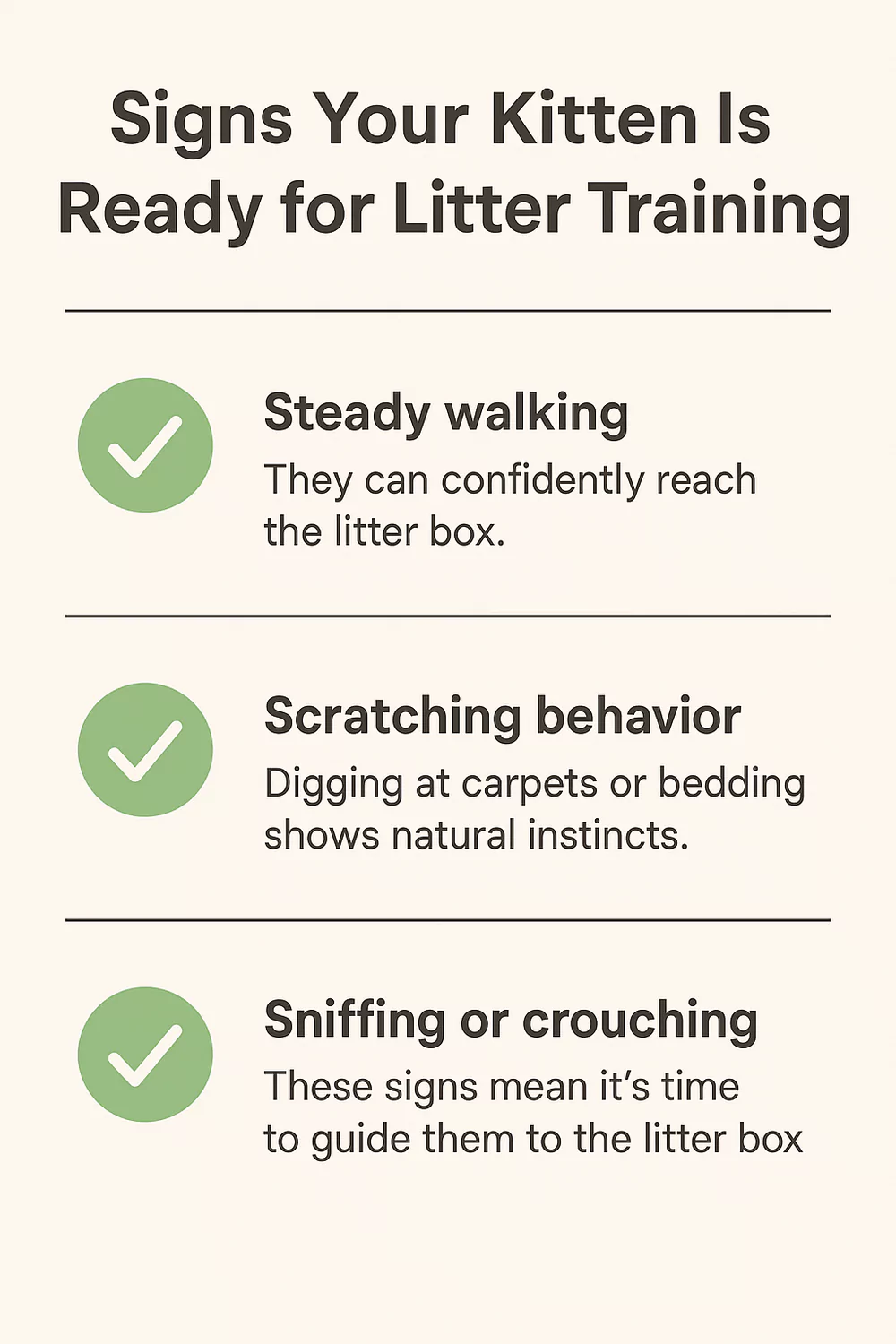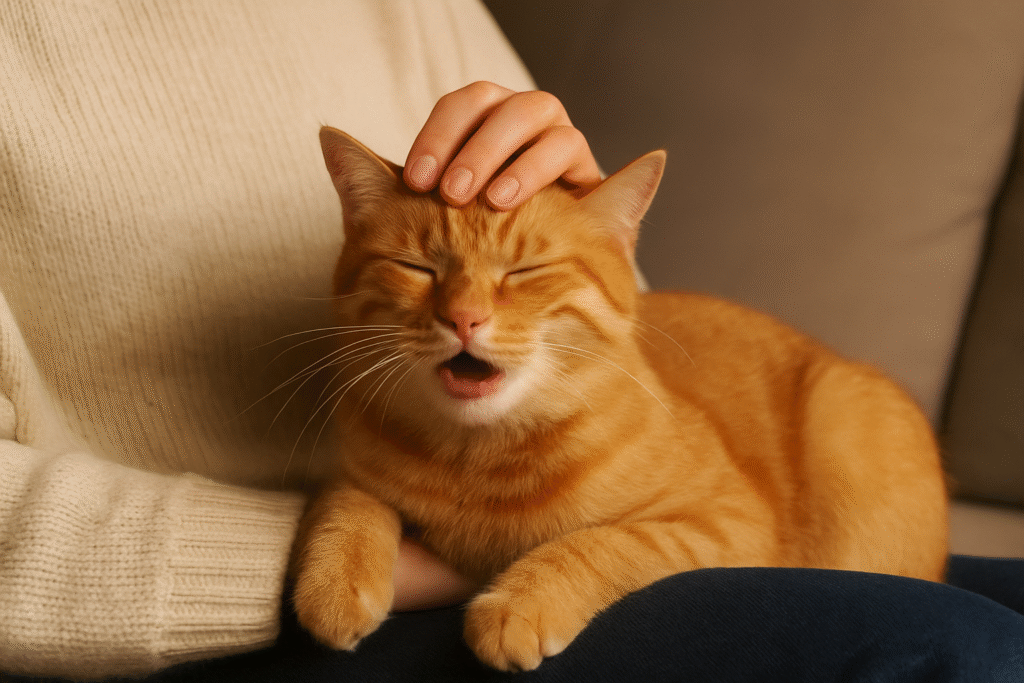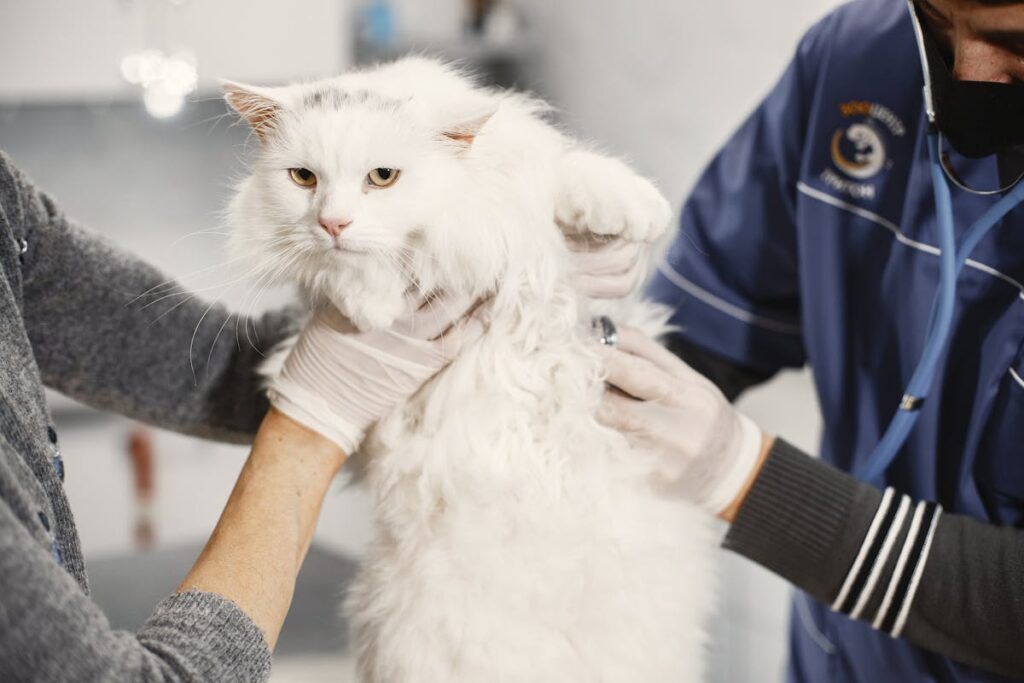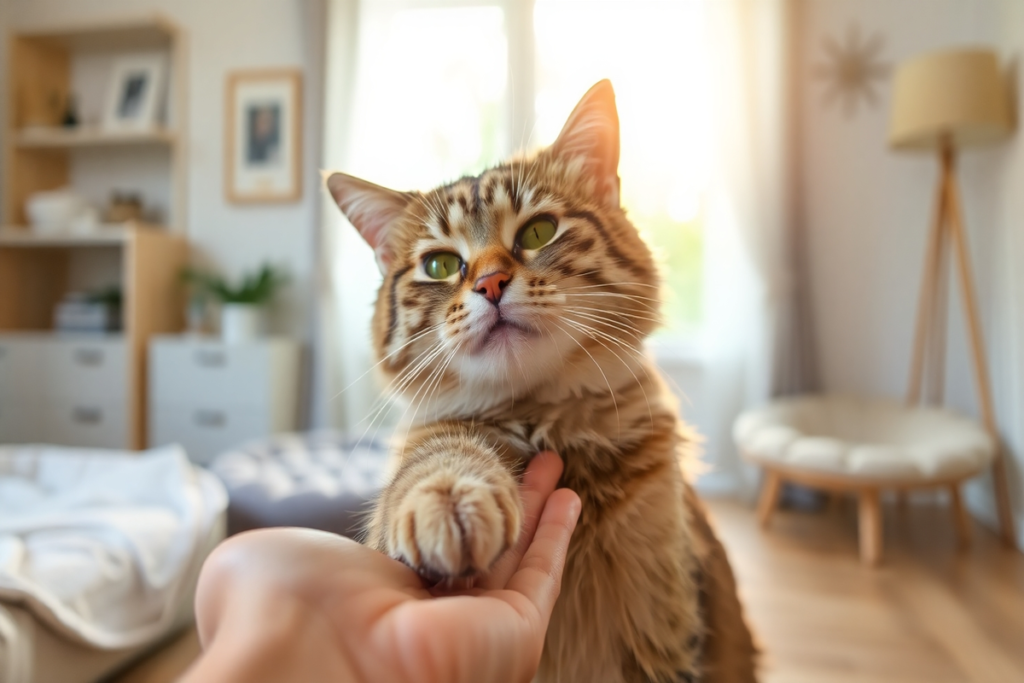Just got a new kitten and want to know the best way to teach it to use the litter box quickly? You’re not alone! One of the first challenges new cat owners deal with is teaching their kittens to use the litter box. Luckily, kittens have an innate tendency to bury their waste, so with a little help, litter training can be quite easy.
Getting started early and having the right tools in place can make a world of difference. In this step-by-step guide, I will teach you how to positively train your kitten, from skillfully selecting the right litter box to forming healthy habits without the hassle or the mess.
When to Start Litter Training
The best time to start litter training a kitten is when they are 3 to 4 weeks of age. By this point in development, kittens gain better control over their muscles, increase their activity level, and will naturally start to explore their surroundings. They will also begin to leave their bedding area to go to the bathroom, and this is normal behavior that you can use to show them the litter box.
Why This Age Matters
At 3 to 4 weeks, kittens are:
- Able to physically navigate and use a litter box independently.
- Curious and open to new experiences.
- Beginning a change from bottle feeding to eating soft food, which also changes potty habits.
Introducing a litter box at an early age helps to avoid unwanted accidents and helps develop healthy hygiene habits early on.
Signs Your Kitten Is Ready for Litter Training:
- Walking without assistance: A kitten that is walking around with purpose is physically prepared to seek out and enter a litter box.
- Digging or scratching behavior: When a kitten is scratching bedding, carpet, or corners, this indicates they are developing the digging instinct that occurs prior to using the bathroom. This behavior is natural to cats.
- Sniffing around or crouching in a corner: These are clear indicators your kitten is about to go. At this time, gently pick up the kit, then, after ensuring it is solidly in the litter box, placing it there will prime your kitten to understand where the u-in occurring is associated.
Kittens this age are physically and mentally ready to learn. Kittens are naturally clean animals and, with the right reinforcement, know where they need to go.

Choosing the Right Litter Box
Choosing the right litter box is one of the most important parts of successfully litter training your kitten. The wrong box – a box that is too large, too high, or not placed in an appropriate location, can discourage use and produce accidents.
Here are some tips for choosing the best litter box that meets your kitten’s needs to help them have the best possible start in litter training.

Pick the Right Size
For kittens, Size really matters. A box that is too big or too deep can be a scary challenge to a kitten or too physically demanding for them to use.
- The best thing to do is find a shallow litter box with a low side (about 2–3 inches tall) that allows them to step in and out on their own.
- Don’t use a high-walled or enclosed box for the first few weeks; this can be intimidating or physically stuck.
- You can also use a baking tray or a shallow storage container until your kitten grows big enough for a normal box.
- As your kitten grows slowly, increase the box size that they use so that they have more space to move and dig comfortably.
A properly sized litter box reduces hesitancy and builds confidence, which are two very important factors in defining a productive litter training experience and outcome.
Covered vs. Uncovered Boxes
Covered and uncovered litter box designs both have pros and cons, but when it comes to kittens, you typically want to use an uncovered litter box first!
Uncovered Litter Boxes:
- Provide easier access for kittens that are small and unable to jump.
- Please provide a clear view of their surroundings, helping kittens feel more secure in their environment.
- It Is easier for you to see kitten usage and maintain cleanliness.
Covered Litter Boxes:
- Provide privacy and control odor.
- Some kittens may feel either frightened or constricted or have difficulty getting into or out of the litter box.
- They are not the best option for training kittens as they often mask observable outcomes of behavior.
Once your kitten grows and becomes contactable with the litter box, you can try a covered one if you would like, but again, always respect your kitten’s comfort and behavior.
Make It Accessible
Even the best litter box won’t do much good if your kitten can’t get to it; placement is most important for your kitten’s consistency.
Placement should be:
- Accessible: Choose a place for your kitten that can be reached all the time and not a high place, stairs, or anything behind a closed-off area.
- Quiet and private: The less noise, foot traffic, and busy rooms (the kitchen or living room) for kittens, the better. Consider a quiet, low-traffic area, such as a corner of a bathroom or a calm hallway for the litter box.
- Away from food and water: Seriously, cats are biologically programmed to avoid eliminating close to where they eat. Be sure you place the litter box away by a few feet from the feeding area.
- Consistent location: Try to avoid moving your box around a lot after you pick a permanent eating area; kittens depend on knowing where things are to establish habits.
If you have a large home or live in a multi-level home, think about having more than one litter box to make sure you always have coverage or a box within reach, especially during the first few weeks of training.
Selecting the Appropriate Litter Box
Picking the right litter is almost as important as choosing a litter box, especially for kittens. Kittens have delicate paws, and because they are very curious, they may explore their litter box with their mouth, so safety and comfort are important.

What Kind of Litter is Best for Kittens?
Not all cat litter is the same, especially when it comes to kittens! Here’s what to pay attention to:
Use Non-Clumping Litter Box
- Non-clumping Cat Litter for Kittens Less than 8 Weeks Old
- Why non-clumping? Kittens that are less than 8 weeks old are more likely to sniff, lick, or taste litter. If a kitten ends up ingesting clumping litter, it can expand in their digestive system, causing serious health problems, including intestinal blockage.
- Using non-clumping litter is safer for young kittens and still absorbs moisture and all the other smells.
Choose Fine-Grain, Unscented Litter
- Soft on paws: Fine-textured litter is smooth and feels natural on tiny paws, encouraging them to use it without inhibition.
- Mimics natural materials: Fine grain litter resembles sand or soil, for example, and is instinctively preferred by all cats for the digging and burying of waste.
- Unscented is preferred: While humans may enjoy a scented litter, strong artificial scents can overpower and deter kittens that tend to have sensitive noses.
What to Avoid?
- Clumping litter (until your kitten is at least 8–12 weeks old)
- Litters that have a strong scent and may overwhelm or chase away kittens.
- Crystal or pellet litter because it may feel too rough or uncomfortable.
Start with the most simple, kitten-safe litter to develop good habits early on. Once they’re older and well-trained, you can easily transition to another type.
Setting Up the Litter Box
Setting up your kitten’s litter box is crucial and will lead to consistent use and less chance of an accident. Here are some key pointers to help you establish the ideal litter box.
Number of Litter Boxes
- Follow the golden rule: One litter box per cat plus an additional. For example, if you have one kitten, having two boxes will be perfect.
- Having more than one box will help the kittens learn and reduce the chance of accidents–this is especially true in the very early stages while they are figuring everything out.
- There are also options for kittens if they encounter a dirty box or a box that is not accessible, which will promote consistency.
Where to Place Litter Boxes
Location is as important as the box itself. Kittens like to use the litter box in places where they feel safe and comfortable.
- Locate litter boxes in quiet, low-traffic areas to avoid unnecessary stress and distractions.
- Position boxes close to their sleeping areas or play spaces so your kitten won’t have difficulty finding the litter box when they need it!
- Similarly, place the litter box away from food and water because cats will instinctively avoid eliminating in the same area where they eat.
- It is best to avoid spots near loud appliances, such as washers or forced air heaters, since loud noises are an easy way to scare a kitten away from the litter box.
- Stay away from high-traffic hallways or open spaces where your kitten might feel vulnerable or exposed.
Choosing a quiet, private area that your cat can easily access the litter box is important because it supports your kitty to feel secure and conducive toward proper box use.
Introducing Your Kitten to the Litter Box
- Timing is everything: As soon as your kitten eats or wakes up, gently place them in the litter box because this is the most natural way for kittens to relieve themselves.
- Encourage natural digging: You can scratch or lightly dig in the litter with your fingers to show the kitten what to do; a kitten has the instinct to dig, and this will help guide them.
- Positive reinforcement: When your kitten uses the box, gently praise him or provide him with a small treat immediately after to reinforce the behavior.
- Be consistent: Follow this protocol on a regular basis throughout the day until your kitten begins to use the litter box on their own without your assistance.
Encouraging Good Litter Box Habits

Use Positive Reinforcement
Always reward your kitten instantly after they correctly use the litter box. Give them gentle praise, some soft petting, or a small treat for using the box correctly. It will create a positive association with the litter box and ensure your kitten will continue using the box.
Avoid Punishment
Do not scold or punish your kitten for accidents outside of the box. Negative reactions to accidents from your kitten can cause unnecessary fear or anxiety in your kitten, and you may avoid using the litter box or well-meaning accidents. Trust must be built – so patience and kindness are important for this.
Establish a Consistent Routine
Having a consistent schedule is important for your kitten and is quite easy to establish! Feeding the kitten at the same time each day will introduce structure. After meals, playtime, and naps, could you direct them to the litter box? Showing your kitten when it is time to go to the litter box is called conditioning and reinforces the correct litter box behavior.
Create a Calm Environment
Keep visits to the litter box calm and low-stress. A routine and positive experiences make it easier for your kitten to learn what is expected of them and be comfortable to use the box.
Maintaining Cleanliness
Scoop Daily
Discard waste from the litter box at least once a day. Cats are naturally clean animals and may avoid using a dirty or smelly box. Consistently adding fresh litter helps entice your kitten to use it.
Deep Clean Weekly
Once a week, empty all of the litter to help prevent odors and bacteria from building up. Wash the box fully with mild soap and warm water to clean and disinfect without harsh chemical residue.
Dry Thoroughly
Once you wash it, make sure the litter box is completely dry before you put in fresh litter. If there is moisture in the litter box, it can cause clumping or simply nursing discomfort for your kitten’s paws.
Create a Healthy Environment
The litter box is important for your kitten’s health and hygiene, and it must remain clean. A fresh, scent free box makes your kitten more willing to return to it, thereby developing proper litter box habits from the very first use.
Troubleshooting Common Issues
If Your Kitten Goes Outside the Box
Learning new things comes with the occasional accident, so don’t panic, and don’t discipline the kitten. Gently lift them and place them back in the litter box to remind them where they should be going.
Identify the Cause
- If the accidents continue, take a look at the common reasons for litter box avoidance:
- Is the litter box clean enough? Dirty boxes can discourage use.
- Is the litter box in a quiet, private area? A litter box located near a loud or busy area may perturb the kitten.
- Is the litter appropriate and comfortable for the age and preferences of your kitten?
When to Call the Vet
Suppose your kitten persistently has accidents despite your best efforts to train it. In that case, this behavior can be indicative of a possible medical issue such as urinary tract infections (UTIs) or digestive problems. A visit to a veterinarian will help rule out potential health issues and hopefully get your kitten back on track.
FAQs
When should I start litter training with my kitten?
Litter training should start at around 3-4 weeks of age when kittens begin to explore and act independently. With nurturing guidance, using the litter box after meals and sleep will maximize litter box learning. Consistent, early training will ensure litter training success!
What type of litter is best for kittens?
Non-clumping, unscented litter is the safest option for kittens under 8 weeks old because they might ingest some litter as they explore their environment. Fine-grained textures are softer on little paws, and they will be more comfortable with it. Scented or crystal litters can be irritating, and kittens have soft, little, sensitive paws. You can switch to clumping litter when they are older.
Why is my kitten not using the litter box?
Kittens tend to avoid the litter box if it is dirty, noisy, or located in a high-traffic area or if there is something about the litter that they do not like! Stress, abrupt environmental changes, or health issues such as infections can also lead to accidents. Make sure the box is clean, located in a quiet, comfortable area, accessible, and no health issues exist before consulting a veterinarian if problems persist.
How many litter boxes do I need for my kitten?
You should have at least one litter box per cat, plus one extra to avoid territorial concerns. For one kitten, use two litter boxes in separate, quiet, accessible spots, and you should be confident starting your training. This way, you will decrease the chances of accidents and have better chances of continued use of the litter box.
Conclusion
Litter training a kitten shouldn’t be hard, but it does require patience, consistency, and an effective setup. Get started as soon as you bring your new kitten home. Think about using a lid with a litter box and select the right litter.
Make a routine with your kitten and provide a positive environment. Given the opportunity and a clean, safe environment, most kittens will pick up on litter training pretty quickly, especially when there is consistency and patience. If you follow these tips, you’ll be on your way to a happy, litter-trained cat and a happy, clean home!





